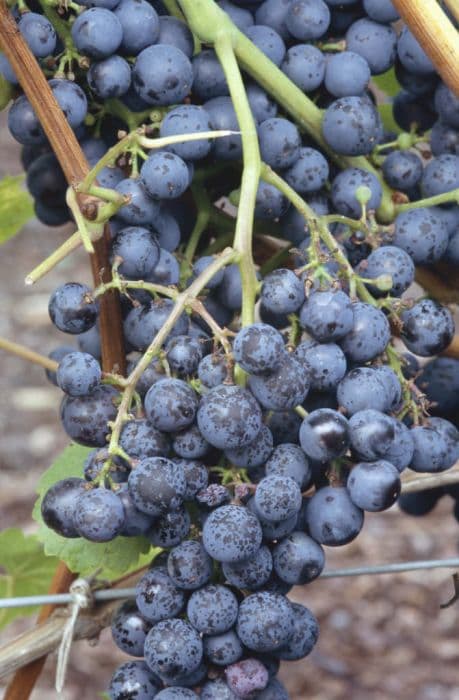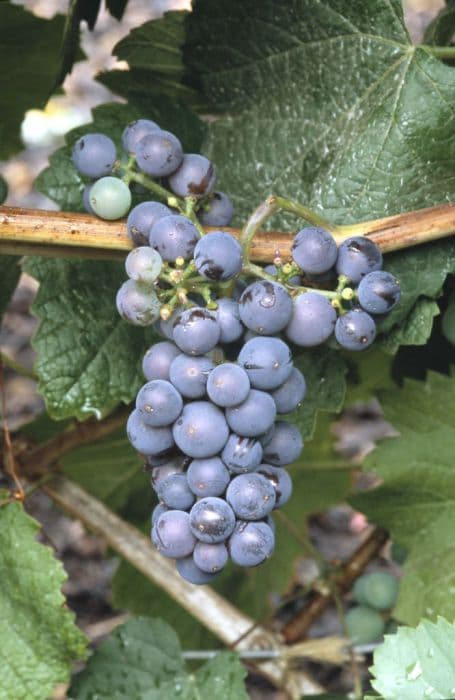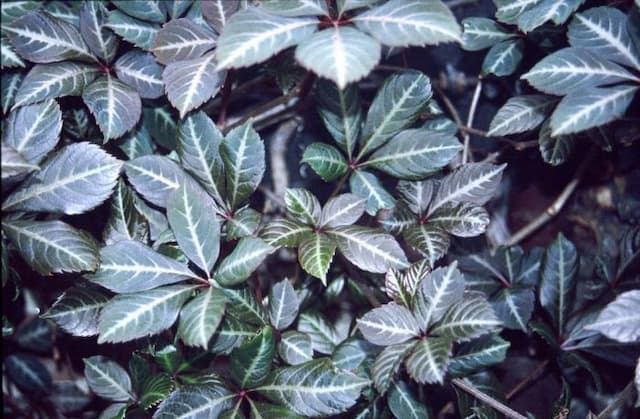Purple Leaf Grape Vitis vinifera 'Purpurea' (O/b)

ABOUT
The grapevine known as 'Purpurea' is admired primarily for its distinctive colored foliage. The leaves of this plant take on a range of hues throughout the growing season, starting with a bright green in spring. As they mature, the leaves become tinged with a deep purple to reddish-purple hue, which intensifies as the weather grows cooler. This rich coloring makes it a standout choice for adding a touch of dramatic color to the landscape. The grapevine also bears clusters of grapes that can vary in color, but typically, they are not the primary focus when this plant is used for ornamental purposes. The grapes are small and may be used to make wine or simply enjoyed as a natural decoration that complements the foliage. The stems of the vine also echo the color scheme, with a reddish-purple tinge that adds to the overall visual appeal. This variety, with its vibrant leaves and decorative fruit clusters, provides a striking visual display in gardens and on trellises.
About this plant
 Names
NamesFamily
Vitaceae.
Synonyms
Purple-leaf Grape, Red-leaf Grape, Ornamental Grape Vine, Purple-leaf Vine.
Common names
Vitis vinifera 'Purpurea'
 Toxicity
ToxicityTo humans
The common name for Vitis vinifera 'Purpurea' is the grapevine. Grapes and raisins, derived from the grapevine, can be toxic if consumed in large quantities, leading to symptoms like nausea, vomiting, and diarrhea. More serious health issues include potentially life-threatening symptoms such as kidney failure, which is rare. Individuals with known sensitivities to grapes should avoid consuming grapes and raisins.
To pets
The common name for Vitis vinifera 'Purpurea' is the grapevine. Grapes and raisins obtained from grapevines are known to be highly toxic to dogs and cats. Symptoms of grape or raisin poisoning in pets can include vomiting, diarrhea, lethargy, abdominal pain, decreased appetite, and it can potentially lead to acute kidney failure, which is a serious and life-threatening condition. Any ingestion of grapes or raisins by pets should be treated as an emergency, and veterinary assistance should be sought immediately.
 Characteristics
CharacteristicsLife cycle
Perennials
Foliage type
Deciduous
Color of leaves
Purple
Flower color
Greenish
Height
35 feet (10.67 meters)
Spread
10 feet (3.05 meters)
Plant type
Climber
Hardiness zones
7
Native area
Mediterranean
Benefits
 General Benefits
General Benefits- Aesthetic Appeal: Adds visual interest to gardens with its attractive purple foliage that intensifies in color during the fall.
- Shade Production: Can be grown over arbors or pergolas, providing natural shade during sunny months.
- Erosion Control: Its root system helps stabilize soil, making it beneficial for hillsides or areas prone to erosion.
- Habitat for Wildlife: Offers food and shelter for various species, including birds that feed on its grapes.
- Fruit Production: Yields grapes that can be used for eating fresh, making jams, jellies, and potentially for wine-making, depending on the variety.
- Seasonal Interest: Provides year-round interest with seasonal changes in leaf color, blossoms in spring, and fruit in late summer or fall.
- Cultural and Historical Significance: Grapes have a long history of cultivation and are linked to various traditions and ceremonies.
- Privacy: When grown on fences or trellises, it can act as a living screen, offering privacy from neighbors or passersby.
- Adaptability: Can grow in a variety of soil types and climates, showing resilience in different growing conditions.
- Garden Design Flexibility: Can be used in various landscape designs, whether trained on structures, left to sprawl, or even grown in containers.
 Medical Properties
Medical Properties- Cardiovascular Health: The grape plant, especially red and purple grape varieties, contains resveratrol and other polyphenols which might contribute to cardiovascular health by improving the health of blood vessels and having an anti-inflammatory effect.
- Antioxidant Properties: Grapes and grape products are rich in antioxidants like flavonoids and resveratrol which can help protect cells from damage and reduce oxidative stress.
- Anti-inflammatory: Compounds found in grapes may have anti-inflammatory properties which might be beneficial in reducing inflammation associated with various conditions.
- Blood Sugar Regulation: There is some evidence to suggest that grape extracts may influence blood glucose levels and improve insulin sensitivity.
 Air-purifying Qualities
Air-purifying QualitiesThis plant is not specifically known for air purifying qualities.
 Other Uses
Other Uses- Ornamental Foliage: The Vitis vinifera 'Purpurea', commonly known as the Purple Leaf Grape, is often cultivated for its attractive purplish-red foliage which adds aesthetic value to gardens and landscapes.
- Dye Production: The deep red leaves of the Purple Leaf Grape can be used to create natural dyes for textiles or art projects.
- Photography Prop: Due to its striking foliage, the plant serves as an excellent prop for photographers seeking to add a touch of natural color to their compositions.
- Garden Structure: When grown on trellises, arbors, or fences, the Purple Leaf Grape can provide a natural, living structure for garden design.
- Educational Tool: Horticulture classes and workshops use the Purple Leaf Grape to teach pruning techniques and vineyard management due to its vigorous growth habit.
- Screening: It can be grown as a dense screen to provide privacy or to hide unsightly areas in a garden setting.
- Erosion Control: The extensive root system of the Purple Leaf Grape can help stabilize sloping land, preventing erosion.
- Shade Provider: When grown over pergolas or other outdoor sitting areas, the Purple Leaf Grape can provide cooling shade in hot climates.
- Craft Material: The flexible canes can be harvested and used in basket weaving or as material for other craft projects.
- Winter Interest: Even after leaf drop in autumn, the twisted vines of the Purple Leaf Grape add visual interest to the garden during the winter months.
Interesting Facts
 Feng Shui
Feng ShuiThe plant Purple-Leaf Grape is not used in Feng Shui practice.
 Zodiac Sign Compitability
Zodiac Sign CompitabilityThe plant Purple-Leaf Grape is not used in astrology practice.
 Plant Symbolism
Plant Symbolism- Prosperity - The grapevine (Vitis vinifera) is often associated with abundance and prosperity, partly due to its historical role as a significant crop in many cultures and the economic importance of wine production.
- Fertility - The grapevine's ability to bear fruit prolifically makes it a symbol of fertility and growth.
- Vitality - As a plant that can live and produce for many years, grapevines symbolize vitality and longevity.
- Transformation - The process of turning grapes into wine represents transformation and change, often in a spiritual or philosophical context.
- Indulgence - Grapes and wine are associated with indulgence, pleasure, and sometimes overindulgence.
- Celebration - Wine from grapes is commonly associated with celebrations and joyous occasions.
 Water
WaterThe Purple-leaf Grape should be watered regularly during its growth season, but it's important to let the soil dry out slightly between waterings. Generally, deep watering once every week with approximately 1-2 gallons per plant is recommended, adjusting as needed for rainfall and temperature. During hot, dry spells, they may need more frequent watering, but it is crucial to avoid waterlogged soil to prevent root rot. In winter, watering can be reduced significantly as the plant is dormant, providing enough to keep the roots from drying out, which may be as little as once a month depending on climate conditions.
 Light
LightPurple-leaf Grape vines thrive in full sun, which means at least 6-8 hours of direct sunlight per day. They perform best and produce the healthiest growth and fruiting when planted in a location that receives unobstructed sunlight throughout the day. Partial shade can be tolerated, but the intensity of leaf color and fruit production may be lessened.
 Temperature
TemperatureThe Purple-leaf Grape prefers a temperate climate and grows best in temperatures between 50°F and 85°F. It can withstand winter chill down to around 20°F, but frost can damage young leaves and shoots. Summertime heat above 90°F may stress the plant, so providing some shade or water to cool it down during extreme heat is beneficial.
 Pruning
PruningPruning is essential for the health and productivity of Purple-leaf Grape vines. Prune in late winter when the plant is dormant, removing dead or overcrowded wood and shaping the plant. This encourages better air circulation, sunlight penetration, and can improve fruit quality. Annual pruning also helps control the plant's size and encourages the growth of new, fruitful vines.
 Cleaning
CleaningAs needed
 Soil
SoilThe best soil mix for the Purple-leaf Grape is one that is deep, fertile, and well-draining with a slightly acidic to neutral pH, ideally ranging between 5.5 and 7.0. A mixture of loam, compost, and perlite or sand will encourage healthy growth and support the vine's root system.
 Repotting
RepottingPurple-leaf Grape vines are vigorous growers but are commonly planted directly in the ground. In a pot, young plants may require repotting every 2-3 years to accommodate root growth. Mature vines, if containerized, should be repotted as needed, which may be less frequent.
 Humidity & Misting
Humidity & MistingPurple-leaf Grape vines are adaptable to a variety of humidity conditions and do not require specific humidity levels to thrive. They grow well outdoors where they can tolerate the natural variations in atmospheric humidity.
 Suitable locations
Suitable locationsIndoor
Ensure full sun, support with a trellis, and allow room to grow.
Outdoor
Plant in full sun, well-draining soil, and provide trellis support.
Hardiness zone
7-9 USDA
 Life cycle
Life cycleThe common name for Vitis vinifera 'Purpurea' is Red-leaf grape. In its life cycle, the Red-leaf grape starts as a seed, which germinates in the soil when conditions are warm and moist, producing a young vine. As the vine matures, it develops a robust root system and woody trunk, along with climbing tendrils, which allow it to support itself on structures or other plants. The plant enters a period of vegetative growth, sprouting large, lobed leaves that can have a purple-red hue, hence the name 'Purpurea'. Following this, it produces inflorescences that bloom and are subsequently pollinated, leading to the development of grape clusters. The Red-leaf grape completes its life cycle by ripening its fruit, which can be harvested and, if conditions such as temperature and humidity are right, the seeds within the grapes can again germinate and give rise to new vines.
 Propogation
PropogationPropogation time
Spring-Early Summer
The Vitis vinifera 'Purpurea', commonly known as Purple-leaf Grape, is often propagated by hardwood cuttings. This method is particularly popular because it is relatively easy and cost-effective. Cuttings are typically taken during the plant's dormant season, which falls in late winter or early spring. Healthy, mature canes from the previous year's growth are selected and cut into lengths of 12 to 18 inches (about 30 to 45 centimeters), each with several buds. The bottom end of the cutting is dipped in rooting hormone to encourage root development and then planted in well-draining soil. The cutting should be placed with about two-thirds of its length buried in the soil to ensure that it has enough depth to develop a strong root system. Adequate moisture and protection from extreme temperatures are essential until the new plants are well established.









